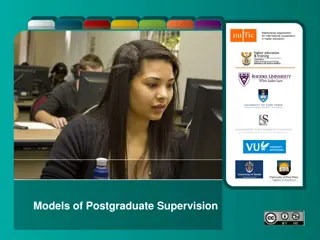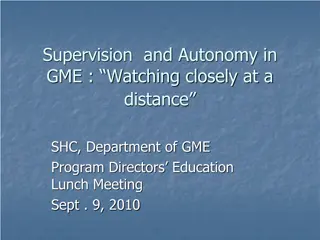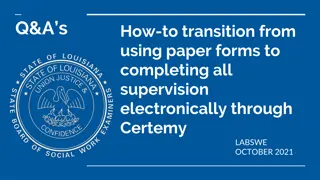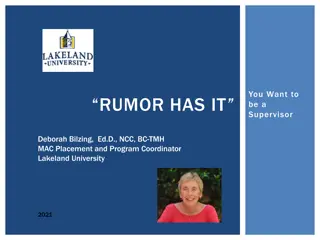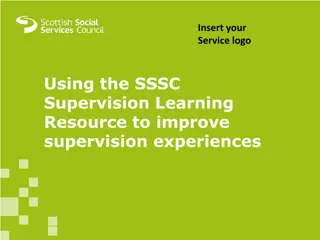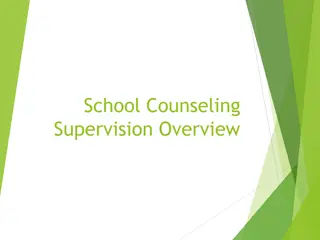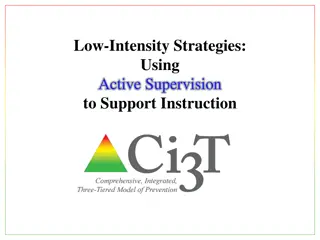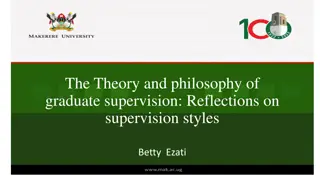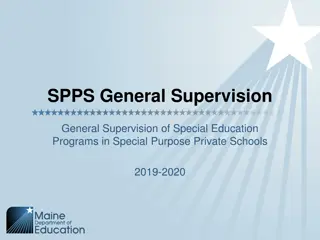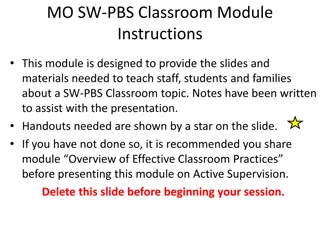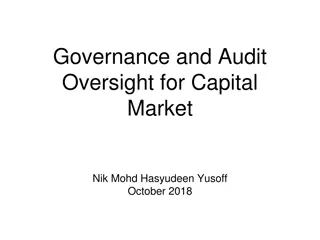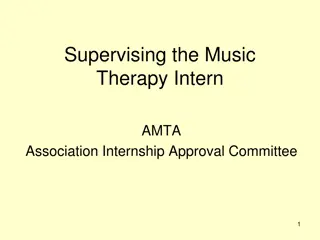Understanding and Implementing Professional Supervision: Navigating the Landscape
Delve into the complex world of professional supervision through exploring its nature, purpose, and common premises. Discover the essential components that shape supervision relationships, theories that guide practice, and personal experiences that influence understanding. Uncover what supervision entails, what it is not, and how it fosters ongoing development and reflection in professional settings.
Download Presentation

Please find below an Image/Link to download the presentation.
The content on the website is provided AS IS for your information and personal use only. It may not be sold, licensed, or shared on other websites without obtaining consent from the author. Download presentation by click this link. If you encounter any issues during the download, it is possible that the publisher has removed the file from their server.
E N D
Presentation Transcript
Workshop 1: A platform of understanding. PPS802 Professional Supervision 2024 NMIT / TE PUKENGA
What we consider to be the nature of supervision, what we think the purpose of supervision is, will then determine all else . the supervision relationship we seek to establish, the theories we draw on to guide us etc. Developing an understanding of supervision as a platform to our supervision practice.
It can be a fraught task however! o Milne et al. (2008) captures the lack of agreement between professions (and sometimes within professions) about the definition of professional supervision. o Grauel s (2002) asserts that supervision is a malleable concept in search of precise definition (Grauel 2002, p. 4).
Developing an understanding of supervision as a platform to practice The literature and theoretical models with regards to their underpinning premises about the nature of supervision Our context how this shapes, determines, influences, makes way for the purpose of supervision Our own experiences of supervision that shape your understanding The terrain or complex landscape of supervision
Common premises about supervision o mandated by and accountable to organization, profession and/or individual o on-going and regular (a process rather than an event) o is educative (but not education) o involves accountability, but it is not management or appraisal o supportive but it is not counselling o focused on the supervisee s agenda o about critical reflection and learning for improved practice and service delivery o about ongoing professional development of practitioner o about development of practitioner knowledge, skills and competence o involves power and authority o is ethical and confidential Davys (2007)
Common premises about what it is not A chat session Gossip Friendship Counselling Management For the supervisor to talk about his or her issues Appraisal Judgemental Davys (2007)
Where does supervision fit with the range of other activities that have a supervisory focus? Northcote (2002)
Clarification of terms Professional Supervision Clinical Supervision primarily focuses on clinical practice and should be provided by a registered practitioner with suitable experience, knowledge and skill that will enable the growth and development in the clinical skills domain of the practitioner. Professional supervision is between those who share the same professional background and training and is central to many professionals employed in health, psychological and social services. Profession supervision is generally between two people and assists practitioners to increase their understanding of oneself; one's relationships with others; to develop more fulfilling and more resourceful ways of providing : and to bring about change in professional behaviour and practice. Davys, et al. (2021) Adapted from Simmons, Carlsson et al. (2007).
Interprofessional supervision Interprofessional supervision (IPS) is with a supervisor and supervisee who do not share the same profession (Davys et al.,2021) Interdisciplinary [Interprofessional ] supervision can be defined as two or more [practitioners] meeting from different professional groups to achieve a common goal of protecting the welfare of the client. This protection is achieved through a process that enables increased knowledge, increased skill, appropriate attitude and values .to maintain clinical and professional competence (Townsend, 2005, p.586)
Cultural Supervision Kaupapa M ori Supervision Supports awareness of own practice with particular ethnicities which may include aspects of kaupapa M ori approaches for Tauiwi working with Tangata whenua. Cultural supervision supports and maintains the interplay of cultural, social and professional identity (Eketone, 2012) ..a framework where the supervision philosophy and functional process is grounded in a M ori worldview and asserts the validity and self- determination of M ori practices as a pathway towards M ori development and wellbeing (Eruera ,2012,p. 18).
Parameters What is the difference between supervision and counselling (EAP)? What is the difference between clinical/professional supervision and line management supervision? The focus of supervision is on professional not personal identity. Personal change for practice development not for its own sake. Line management involves hierarchy and the monitoring of performance to meet organizational goals and has a responsibility to make sure employee has what they need to do the job. There is a far greater organizational agenda in line management supervision. The supervisor, unlike the therapist, does not suspend critical judgement and supervision operates within the boundaries of performance expectations and standards established by professional and organisational bodies. A dual role of line management may coexist in supervision. Fox 1989
Theoretical and Philosophical positions and the underpinning emphases as to the nature of supervision . The heart of supervision is learning. The medium of learning in supervision is reflection. The focus of reflection in supervision is the work or practice of the supervisee. Supervision is an inquiry into practice. It is a compassionate appreciative inquiry In supervision we re-write the stories of our own practice supervision interrupts practice. It wakes us up to what we are doing. When we are alive to what we are doing we wake up to what is, instead of falling asleep in the comfort stories of our clinical routines Carroll, M. (2010) Supervision: Critical Reflection for Transformational Learning (Part 2), The Clinical Supervisor, 29:1 19 Ryan, S. (2004) Vital Practice, Portland, USA. Sea Change Publications. p. 44.
References Davys, A., Fouche, C., & Beddoe, E. (2021) Mapping effective interprofessional supervision practice. The Clinical Supervisor: 40(2) 179-199. Davys, A. (2007). Active participation in supervision: A supervisee's guide In D. Wepa (Ed.), Clinical Supervision in Aotearoa/New Zealand: A Health Perspective (pp. 26-42). New Pearson Ed. Eruera, M. (2012) He Korero Korari . Aotearoa New Zealand Social Work, (24), 3 &4, 12-19. Grauel, T. (2002). Professional Oversight: the neglected histories of supervision. McMahon & W. Patton (Eds.), Supervision in the Helping Professions: a practical approach. (pp. 261-271). Prentice Hall. In: M.
Eketone, A. (2012). The purposes of cultural supervision. Aotearoa New Zealand Social Work, 24(3&4), 20-30. Fox, R. (1989). Relationship: The cornerstone of clinical supervision. Social Casework, 70, 146- 152. Milne, D., Aylott, H., Fitzpatrick, H. & Ellis, M. V. (2008). How Does Clinical Supervision Work? Using a 'Best Evidence Synthesis' Approach to Construct a Basic Model of Supervision. The Clinical Supervisor, 27(2),170 - 190. Morrison, T. (2005). Staff supervision in social care: Making a real difference for staff and service users. Pavillion. Northcott, N. (2000) Clinical Supervision: Professional development or management control. In J. Spouse & L. Redfern (eds.)Successful supervision in health care practice. (pp. 10-29) Blackwell Science Ryan, S. (2004) Vital Practice. Sea Change Publications.


